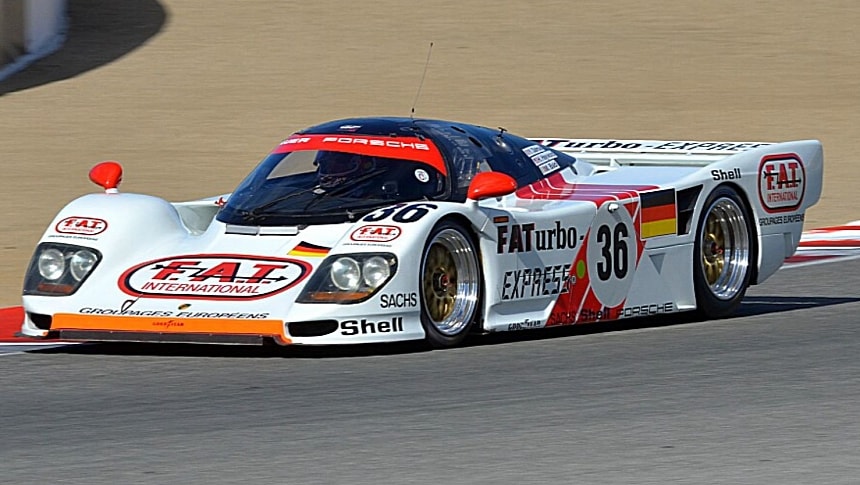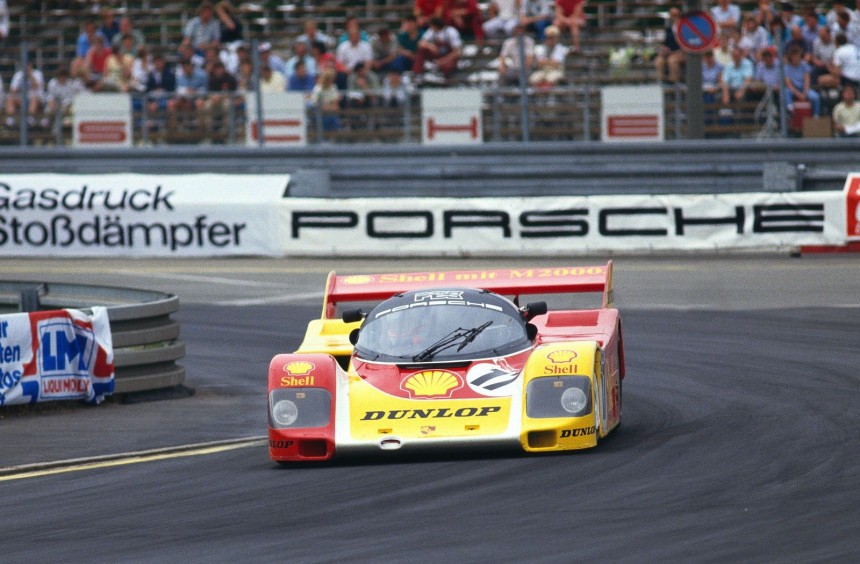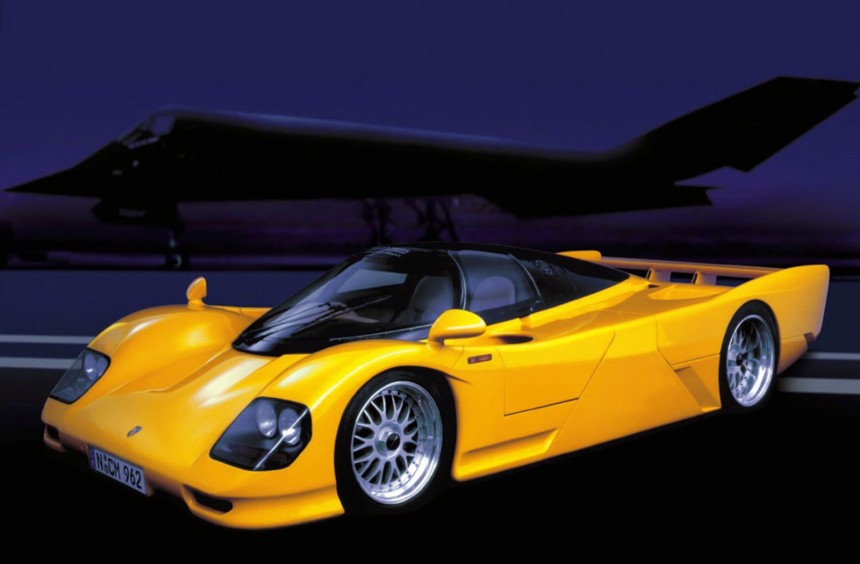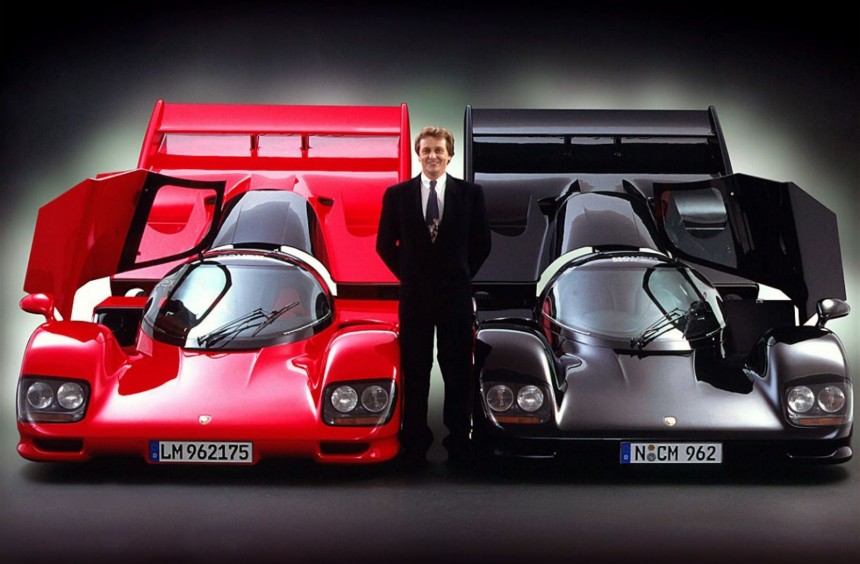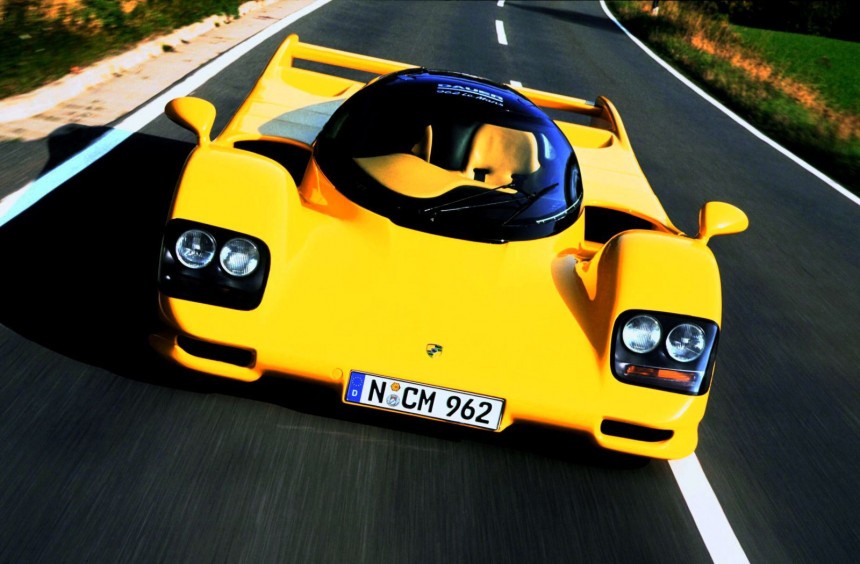In 1994, rulebook loophole masters Porsche shocked the motorsport world by winning at Le Mans with a mid-1980s car that hadn't been competitive in the legendary 24-hour race for over six years.
Over the last 100 years, the Circuit de la Sarthe, located near the town of Le Mans in France, has been the place where some of the most epic motorsport stories were written.
From Bentley's dominant run during the race's early years to Ford's 1-2-3 finish in 1966, or, more recently, Ferrari's epic comeback win last year (2023), the 24 Hours of Le Mans has never ceased to thrill.
Though 25 different manufacturers have at least one overall win to their name, Porsche is by far the most successful, with no less than 19 victories, seven of which came consecutively, from 1981 to 1987.
Each Porsche triumph has its own story, but arguably the most fascinating is the one that came 30 years ago when the German manufacturer took advantage of a loophole in the regulations (again) and crossed the finish line first with the aging 962.
Although it had been a constant presence at Le Mans since 1951, Porsche's first overall win came in 1970 with the 917K, a feat that was repeated in 1971.
The triumph marked the first time when the manufacturer exploited a loophole in the regulations by making what was essentially a prototype race car road legal and entering it into the five-liter Group 4 class.
The 917K was replaced by the three-time Le Mans-winning 936 after 1971.
In 1982, Porsche launched the 956, which helped it rack up four consecutive victories at the famous endurance race.
By the end of the 1984 season, the 956 evolved into the 962, another successful prototype that racked up two more Le Mans trophies in 1986 and 1987.
Powered by various iterations of Porsche's race-bred turbocharged flat-six, the 962 continued to compete until 1993. However, from 1990 onwards, it became agonizingly uncompetitive since it was subjected to newer technical regulations that impacted its performance.
By 1994, everyone expected Porsche to retire the aging car and announce a modern successor. However, the Zuffenhousen-based carmaker went on to exploit the rulebook once again and brought back the 962 for one final dance.
For the 1994 race, the Automobile Club de l'Ouest (ACO) reintroduced a production-based grand tourer-style class (GT1) in an effort to lure supercars like the McLaren F1, Ferrari F40 or Bugatti EB110 into the famous endurance race.
To compete in this new class, manufacturers had to field a production car-based challenger with a 120-liter fuel tank, up to 650 hp, a minimum weight of 1,000 kg, and a maximum tire width of 14 inches.
The top prototype class was now dubbed LMP1 and required an 80-liter fuel tank, a maximum output of 550 bhp, a minimum weight of 900 kg (920 kg for turbo cars), and a maximum tire width of 16 inches.
The 962 could race in LMP1, but due to its aging design, it stood no chance against the newer and faster Toyota 94C-V, which, with the retirement of past winners Peugeot, was the unanimous favorite to win the race.
However, with narrower tires, a larger fuel tank, and a new air restrictor, the aging Porsche could enter the GT1 class and theoretically make up for the lack of speed with fewer pit stops and thus stand a chance to win the race.
But there was a problem: the 962 was conceived as a Group C prototype, so it wasn't based on a road-legal model.
Nevertheless, Porsche read between the rulebook's lines and discovered that ACO didn't specify a minimum number of road-legal cars required for GT1 homologation.
Since several independent carmakers had already successfully built 962-based street cars and even converted actual race cars for road use, the German manufacturer took the opportunity to partner up with one and thus earn homologation for the GT1 class.
Founded by Jochen Dauer, a former racing driver turned successful businessman, Dauer Racing had a fleet of 962s that it used to race in several competitions during the second part of the 1980s.
However, due to newer regulations and lack of funding, Dauer was forced to retire from motorsport after the 1990 season.
With the fleet of 962 left to gather dust, Jochen Dauer had the brilliant idea of converting several units into road cars.
The first such road-legal 962, dubbed Dauer 962 Le Mans, was unveiled at the Frankfurt Motor Show in 1993.
Powered by an unrestricted version of the race-bred Type 935 twin-turbocharged 3.0-liter flat-six rated at 720 hp, it accelerated to 62 mph (100 kph) from a standstill in just 2.8 seconds and reached a top speed of 251.4 mph (404.6 kph), making it the fastest production car in the world.
Like Porsche, Jochen Dauer wanted to exploit the GT1 homologation requirements, and after selling several road-going 962 LMs, he planned to enter a race version into the 1994 edition of Le Mans.
Unfortunately, things didn't go according to the initial plan, as the team ran out of funds to continue production after only a couple of complete cars.
Dauer almost abandoned the project, but thankfully, Porsche stepped in with an irrefusable proposition.
Rather than spend precious time developing a road-legal 962 themselves, Porsche engineers reasoned that partnering up with Dauer was the perfect solution to gain GT1 homologation.
Thus, famed Porsche engineer Norbert Singer approached Jochen Dauer with the the idea of a joint Le Mans effort, and after agreeing to terms, the two teams went on to develop three 962s for the 1994 race.
With a road car having been already built, the joint team of Dauer and Porsche/Joest Racing engineers only had to add the street car's luggage compartment, a 120-liter fuel tank, and an air restrictor that limited the twin-turbo engine's output to 650 hp.
In just a couple of months, three cars were ready for Le Mans, but the newly founded team dubbed Le Mans Porsche elected only to use two for the race.
During qualifying, both cars were sensibly slower than the Toyota, Courage, and Kremer LMP1 prototypes, finishing the session 5th and 7th.
Though Porsche stated that it was aiming for an overall win in the race, everyone laughed them off and expected Toyota to cross the finish line first with ease.
But, despite being heavier, aerodynamically inferior, and thus slower, the Dauer 962 LMs had one key advantage: a much larger fuel tank.
During the race, both Dauers had to overcome several incidents, but fortunately, none were serious enough to force them to retire.
Ultimately, the race went according to Porsche's plan and, although the cars were slower than the LMP1 prototypes, they made fewer pit stops.
Much to everyone's surprise, the no. 36 car co-driven by Yannick Dalmas, Hurley Haywood, and Mauro Baldi crossed the finish line first, one lap ahead of Toyota Team Sard's 94C-V prototype.
Even more impressive, the no. 35 Dauer 962 LM of Hans-Joachim Stuck, Danny Sullivan, and Thierry Boutsen finished third, only two and a half seconds behind the Toyota.
After helping Porsche rack up its 13th Le Mans victory, the 962 was finally retired.
Consequently, the governing body banned prototype-style cars from entering the GT1 class, yet it continued to allow legal one-off-road cars to be homologated.
Porsche partnered up with TWR and came back to Le Mans in 1995 with a new prototype dubbed WSC-95. The car was successful from the get-go, earning the manufacturer two more Le Mans victories.
Then, in 1996, the German carmaker won the iconic race once again with the GT1-class 911 GT1-98.
Thirty years after its unlikely triumph, the Dauer 962 LM remains one of the most fascinating Le Mans winners of all time. It proved that a clever interpretation of the rulebook could outmatch technical superiority, and despite its aging design, it became a motorsport legend.
For more info about this captivating car, we recommend watching the YouTube video below by Aidan Millward.
From Bentley's dominant run during the race's early years to Ford's 1-2-3 finish in 1966, or, more recently, Ferrari's epic comeback win last year (2023), the 24 Hours of Le Mans has never ceased to thrill.
Though 25 different manufacturers have at least one overall win to their name, Porsche is by far the most successful, with no less than 19 victories, seven of which came consecutively, from 1981 to 1987.
Each Porsche triumph has its own story, but arguably the most fascinating is the one that came 30 years ago when the German manufacturer took advantage of a loophole in the regulations (again) and crossed the finish line first with the aging 962.
A brief history of the Porsche 962
The triumph marked the first time when the manufacturer exploited a loophole in the regulations by making what was essentially a prototype race car road legal and entering it into the five-liter Group 4 class.
The 917K was replaced by the three-time Le Mans-winning 936 after 1971.
In 1982, Porsche launched the 956, which helped it rack up four consecutive victories at the famous endurance race.
By the end of the 1984 season, the 956 evolved into the 962, another successful prototype that racked up two more Le Mans trophies in 1986 and 1987.
Powered by various iterations of Porsche's race-bred turbocharged flat-six, the 962 continued to compete until 1993. However, from 1990 onwards, it became agonizingly uncompetitive since it was subjected to newer technical regulations that impacted its performance.
By 1994, everyone expected Porsche to retire the aging car and announce a modern successor. However, the Zuffenhousen-based carmaker went on to exploit the rulebook once again and brought back the 962 for one final dance.
The GT1 loophole
To compete in this new class, manufacturers had to field a production car-based challenger with a 120-liter fuel tank, up to 650 hp, a minimum weight of 1,000 kg, and a maximum tire width of 14 inches.
The top prototype class was now dubbed LMP1 and required an 80-liter fuel tank, a maximum output of 550 bhp, a minimum weight of 900 kg (920 kg for turbo cars), and a maximum tire width of 16 inches.
The 962 could race in LMP1, but due to its aging design, it stood no chance against the newer and faster Toyota 94C-V, which, with the retirement of past winners Peugeot, was the unanimous favorite to win the race.
However, with narrower tires, a larger fuel tank, and a new air restrictor, the aging Porsche could enter the GT1 class and theoretically make up for the lack of speed with fewer pit stops and thus stand a chance to win the race.
But there was a problem: the 962 was conceived as a Group C prototype, so it wasn't based on a road-legal model.
Nevertheless, Porsche read between the rulebook's lines and discovered that ACO didn't specify a minimum number of road-legal cars required for GT1 homologation.
Since several independent carmakers had already successfully built 962-based street cars and even converted actual race cars for road use, the German manufacturer took the opportunity to partner up with one and thus earn homologation for the GT1 class.
The Dauer 962 Le Mans road car
However, due to newer regulations and lack of funding, Dauer was forced to retire from motorsport after the 1990 season.
With the fleet of 962 left to gather dust, Jochen Dauer had the brilliant idea of converting several units into road cars.
The first such road-legal 962, dubbed Dauer 962 Le Mans, was unveiled at the Frankfurt Motor Show in 1993.
Powered by an unrestricted version of the race-bred Type 935 twin-turbocharged 3.0-liter flat-six rated at 720 hp, it accelerated to 62 mph (100 kph) from a standstill in just 2.8 seconds and reached a top speed of 251.4 mph (404.6 kph), making it the fastest production car in the world.
Like Porsche, Jochen Dauer wanted to exploit the GT1 homologation requirements, and after selling several road-going 962 LMs, he planned to enter a race version into the 1994 edition of Le Mans.
Unfortunately, things didn't go according to the initial plan, as the team ran out of funds to continue production after only a couple of complete cars.
Partnering up with Porsche
Rather than spend precious time developing a road-legal 962 themselves, Porsche engineers reasoned that partnering up with Dauer was the perfect solution to gain GT1 homologation.
Thus, famed Porsche engineer Norbert Singer approached Jochen Dauer with the the idea of a joint Le Mans effort, and after agreeing to terms, the two teams went on to develop three 962s for the 1994 race.
With a road car having been already built, the joint team of Dauer and Porsche/Joest Racing engineers only had to add the street car's luggage compartment, a 120-liter fuel tank, and an air restrictor that limited the twin-turbo engine's output to 650 hp.
In just a couple of months, three cars were ready for Le Mans, but the newly founded team dubbed Le Mans Porsche elected only to use two for the race.
An unlikely outcome
Though Porsche stated that it was aiming for an overall win in the race, everyone laughed them off and expected Toyota to cross the finish line first with ease.
But, despite being heavier, aerodynamically inferior, and thus slower, the Dauer 962 LMs had one key advantage: a much larger fuel tank.
During the race, both Dauers had to overcome several incidents, but fortunately, none were serious enough to force them to retire.
Ultimately, the race went according to Porsche's plan and, although the cars were slower than the LMP1 prototypes, they made fewer pit stops.
Much to everyone's surprise, the no. 36 car co-driven by Yannick Dalmas, Hurley Haywood, and Mauro Baldi crossed the finish line first, one lap ahead of Toyota Team Sard's 94C-V prototype.
Even more impressive, the no. 35 Dauer 962 LM of Hans-Joachim Stuck, Danny Sullivan, and Thierry Boutsen finished third, only two and a half seconds behind the Toyota.
The aftermath
Consequently, the governing body banned prototype-style cars from entering the GT1 class, yet it continued to allow legal one-off-road cars to be homologated.
Porsche partnered up with TWR and came back to Le Mans in 1995 with a new prototype dubbed WSC-95. The car was successful from the get-go, earning the manufacturer two more Le Mans victories.
Then, in 1996, the German carmaker won the iconic race once again with the GT1-class 911 GT1-98.
Thirty years after its unlikely triumph, the Dauer 962 LM remains one of the most fascinating Le Mans winners of all time. It proved that a clever interpretation of the rulebook could outmatch technical superiority, and despite its aging design, it became a motorsport legend.
For more info about this captivating car, we recommend watching the YouTube video below by Aidan Millward.
